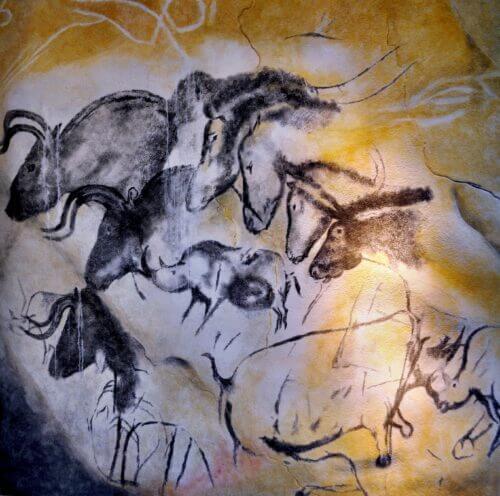Hundreds of meters of realistic wall paintings, the oldest of which are 36 thousand years old, depict vivid and sometimes even three-dimensional descriptions of the local nature at the same time when herds of cattle and wild horses roamed the area, lionesses hunted for prey, and more. The cave was discovered in 1994, and about twenty years later a replica of it was opened to the public in order to prevent damage to the original cave

Cave returned In southeastern France is a labyrinth of corridors between stalactites and rocks, where wall paintings were discovered on December 18, 1994, the oldest of which are 36 years old.
Joshua Hammer, described in an article for the journal of the Smithsonian Museum How three friends who hike together on weekends – Jean-Marie Shoba, Elit Brunel and Christian Hillier – followed a current of air into a narrow opening in a chalk cliff, dug their way through a narrow passage, using hammers and shovels to work their way through the rocks and fragments of stalactites that blocked the their progress, descending into a frozen world when its main entrance was blocked by a massive rockfall 29,000 years ago.
Look for stalactites and find paintings
Brunel, the first to pass through the passage, was interested in the surreal crystalline sediments built by nature over thousands of years, then stopped when she saw a pair of fuzzy red lines drawn on the wall to her right. "They were here," she shouted.
The trio moved gently across the cave floor, trying not to step on the petrified ash at the bottom of an ancient fire pit and gazed in wonder at the hundreds of paintings. "We found ourselves in front of a rock wall completely covered in red paintings", the three stated in the book in which they detailed their memories of the discovery. ” A mammoth with a long belly, then a lion with red dots sprayed around him in an arc, like drops of blood. We bent over our heels, looking at the cave wall speechless."
Across six spaces in the cave whose walls extend for 400 meters there were paintings of lionesses in pursuit of large herbivores - including the wild ox, the extinct ancestors of a local cattle species as well as bison; engravings of woolly owls and rhinoceroses; A charcoal portrait of four wild horses, and about 400 other images of animals that roamed the plains and valleys in the area in huge numbers during the Ice Age. With a skill never before seen in cave art, the artists used bumps, depressions and other irregularities in the limestone to give a sense of dynamism and three-dimensionality to the galloping, leaping creatures. Later, Jean-Marie Shuba marveled at the "extraordinary realism" and aesthetic mastery" of the artworks encountered that day.
A revolution in human creativity
Within months, the cave, officially named Chauvet-Pont d'Arc, after one of the discoverers provided a revolution in our understanding of human creations in prehistoric times. Radiocarbon dating of 80 charcoal samples from the paintings determined that most of the works date back to 36,000 years ago, more than double the age of any similar cave art up to that time. The scientists determined that a second wave of Paleolithic artists entered the cave 5,000 years later and added dozens of paintings to the walls. Scholars have had to radically change their estimates of the period when Homo sapiens first developed symbolic art and began to unleash the power of imagination.
At the height of the Aurian period 40,000 to 28,000 years ago - when the Homo sapiens shared the territory with the dominant Neanderthals, perhaps this artistic impulse signaled an evolutionary leap.
While the Homo sapiens were experimenting with perspective and creating early paintings on the walls, their cousins, the Neanderthals, were teetering on the brink of extinction, never going beyond making crude rings and lines. The find also proved that Paleolithic artists painted in a consistent style, using similar techniques for 25,000 years - an extraordinary stability that is the mark of classical culture, wrote Gregory Curtis in his book "The Cave Painters".
At the beginning of the article, the writer Joshua Hamer tells how he got to the cave, passed through rooms of stalactites and reached the area where the paintings are, which he illuminated with the flashlight of his phone. But don't worry. There is no fear that tourists will spoil the original cave, which is also inaccessible. In 2015, 500 artists trooped to the area and one by one restored the magical cave with the construction efforts of the 21st century and a budget of about 60 million euros. Of course, the cave became a UNESCO heritage site.
More of the topic in Hayadan:

3 תגובות
If they release Asian elephants in Novaya Zemlya (or anywhere else in Siberia). They will provide them with water in the winter, and food. After a few generations these elephants will look like mammoths. If they are raised in Europe, the Indian gaur, then after a few generations it will look like a wild ox
https://artsandculture.google.com/project/chauvet-cave
Stunning
My son drew this I told him not to dirty the walls but he doesn't listen to me sorry it was a few years ago when he was little how did you get to 36 thousand years did you drift away